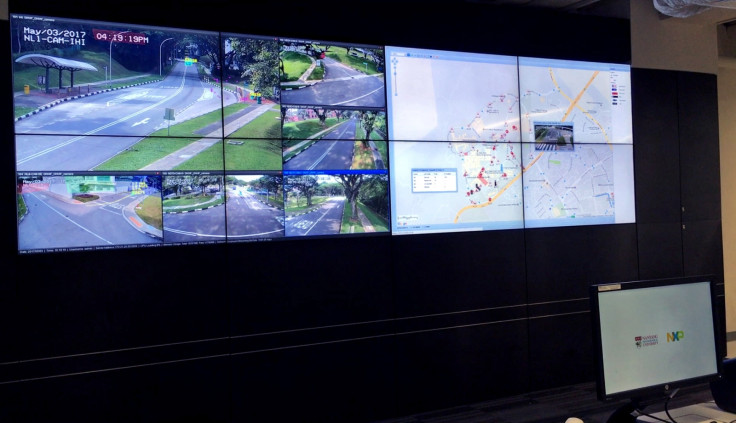Singapore racing to make self-driving cars and advanced road safety a reality
Nanyang Technological University is developing computer algorithms that lets cars talk to each other.
As hype around self-driving cars continues, in Singapore researchers are looking at ways of ensuring that autonomous vehicles are 100% safe, and to that end Nanyang Technological University (NTU) is currently home to a live testbed for self-driving and connected car technologies.
For self-driving cars to be possible, we will need to have not just smart vehicles armed with multiple sensors to pick up information about road and weather conditions, but also incredibly smart computers that are constantly connected to the internet and each other to ensure that cars have all the information they need to make decisions.
NTU engineers and computer scientists are currently working on computer algorithms and the hardware that would be needed to help cars talk to each other and to fixtures on the roads – a field of research known as Vehicle2Vehicle (V2V) communication and Vehicle2Infrastructure (V2X) communication.
To make sure it works, the university has turned its 200-hectare (494-acre) campus into a live test bed for what it calls "smart mobility" technologies, which IBTimes UK got to see in action in Singapore last week.
A network just for connected cars

NTU is now host to a real, live, working wireless network that runs on a new radio protocol IEEE 1609 and the older IEEE 802.11p, which are standards created just for vehicles. So far 12 partners including government agencies, academic institutions and companies like Panasonic, BMW and Rolls Royce are using the campus to test out concepts and new solutions, such as smart traffic cameras.
The university's engineers and computer scientists are developing a smart on-board system that will contain the car's brains and provide access to the internet. The Wi-Fi-enabled box has been fitted to 50 vehicles, while 35 lamp posts on the campus have been turned into wireless access points armed with roadside units and video cameras.
We were given a demonstration of the on-board system rigged up to a van and a car. As we travelled around the campus, the box in the van communicated with lamp posts and the car in front of it. When we entered a toll zone, the companion app calculated the fee the van needed to pay.
And when the car in front of us suddenly braked without warning, the car's on-board system sent a message to the van, and an alert came up asking the driver of the van to stop. Of course, we were being driven around by manned vehicles, but if the van had been autonomous, it would have braked automatically.
Self-driving vehicles like French firm Navya's Arma autonomous shuttle bus are also being tested on the campus, and the intent is to improve the vehicles' capabilities using V2V research.
A need to improve road safety
However, it's not all just about autonomous vehicles – the researchers also want to improve safety for drivers too. In many countries, use of mobile phones while driving has become one of the highest causes of car accidents, so even if people don't want to put their lives in the hands of robots, we need to find a way to keep human drivers safe.
"At the moment when we drive and we make use of a GPS navigator in the car, we're only aware of ourselves on the road. But imagine that another car is able to talk to you, and he tells you where he is, especially if he's in your blind spot, which is a dangerous place to be," Dr Guan Yong Liang, an associate professor with NTU's School of Electrical and Electronic Engineering and the project lead on the Smart Mobility programme told IBTimes UK.
"If the cars could talk to each other, wouldn't it make driving much safer? And in case of a collision, if the two cars already know of each other's presence even if the driver isn't paying attention, then something can be done to alert the driver and stop the car to save lives."
Futuristic technologies being tested now

Despite laws and fines, smartphone use while driving is still a key source of distraction, so perhaps the car needs to take notice when the driver isn't. To this end, the NTU campus also has its own command centre where researchers can monitor traffic on the roads from both driven and driverless cars in real time to learn more about peak traffic times and driver behaviour, as well as to receive data from test vehicles and the access points.
The researchers and partners are currently using the test bed at NTU to research everything from emergency broadcasting of accidents to vehicles; to ways for vehicles to be tracked and geolocated without GPS; to advanced traffic signal control algorithms; to the antennas needed for vehicles and roadside access points; to even light field imaging to help the computers in vehicles calculate distances between them.
NTU also claims that it is working on the world's biggest test track for self-driving vehicles, which will open at the end of 2017, although it has not said how big the track will be. In any case, to be the world's biggest, it will need to beat South Korea, which has announced that it is building an 88-acre site called "K-City" which will feature autonomous carparks and bus-only lanes on expressways.
© Copyright IBTimes 2025. All rights reserved.






















